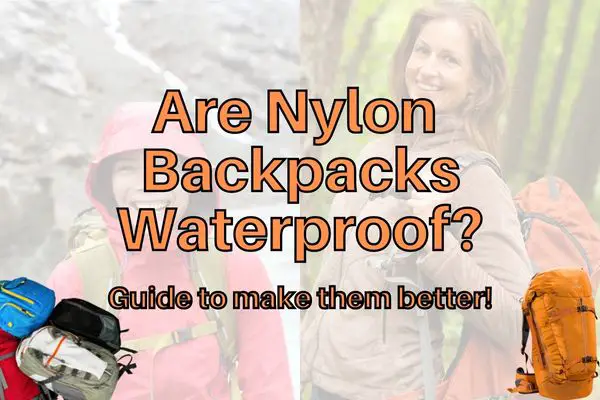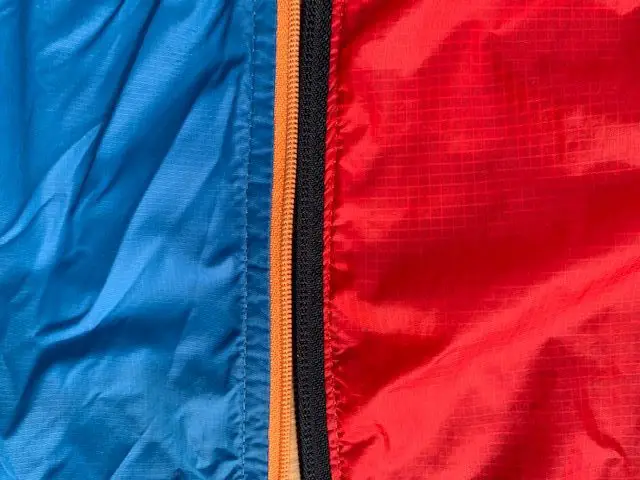Many backpacks are made of synthetic fabrics that are lightweight and durable, but their degree of water resistance varies.
Nylon is often used in outdoor gear like tents, jackets, sleeping bags, and backpacks because it is lightweight as well as resistant to water and abrasion.
While all types of nylon fabric confer some resistance to water, far from all nylon backpacks are waterproof. Most are only water-resistant, which means they will protect your belongings from light rain or splashes but not from being submerged in water.
Keep in mind that even if a backpack is advertised as waterproof, the zippers and seams may not be fully sealed and could allow water to enter the bag.
So, it’s always best to bring a rain cover or pack your belongings in plastic bags or waterproof stuff sacks before putting them in your hiking backpack, just in case.
However, after reading this article you will know what types of nylons are most water-resistant and how to make any backpack fully waterproof at home!
Contents
What is nylon and where is it used?
Nylon is a manufactured synthetic textile made from polyamides. It was originally invented as an alternative to soft natural fabrics such as silk, but is now used in many different thicknesses for many other purposes than clothing – backpacks, for example!
Nylon is widely used in outdoor gear in everything from clothing and ropes to tents, sleeping pads, sleeping bags, and backpacks.
It is known for its high strength-to-weight ratio and is therefore also used in fishing nets, parachutes, and hot air balloons!
Most modern nylons used in garments and tents are made with the so-called rip-stop technique, which means that more robust nylon yarns (thicker than the main material) are woven into the fabric at regular intervals.
Rip-stop ensures that any tears of the thin main fabric cannot extend along and end of ripping the whole sheet apart.
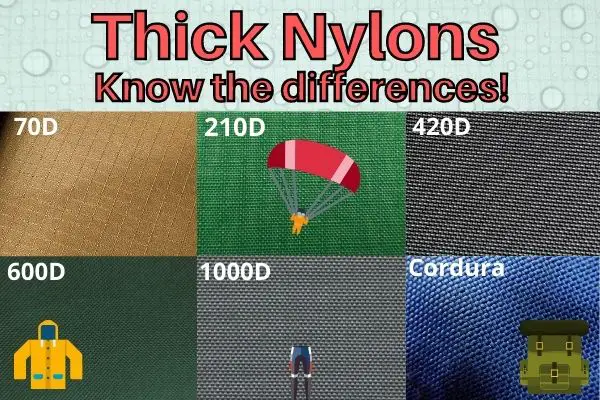
Check out my recent post on the nylon materials most often used for backpacks (click the image).
Due to its relatively low price and high functionality, nylon is the material of choice for weight-critical products such as camping tents and hiking backpacks.
It is a very versatile fabric as it can be made in almost any thickness and strength.
Although, practically, nylon is only made down to a thickness of 7D (used in some tents) and up to a thickness of around 1700D (used for ballistic jackets).
The “D” postscript, also known as the “Denier” value, is used for nylon and polyester fabrics to state the thickness of the thread used to make the fabric. You can read much more about Denier in my post about nylon fabrics here on the blog.
The nylon used for backpacks is something in between those two. Typically in the 100D to 600D range.
Why is nylon a good material for backpacks?
Nylon is a good material for backpacks for a few reasons.
First, it’s durable and can withstand a lot of wear and tear. Nylon fabrics for backpacks can be made in thicknesses of less than that of a hair to several millimeters.
Thinner materials are often used for packable daypacks or ultralight hiking backpacks, whereas the thicker nylon materials are often used for the more heavy-duty military-style packs – the thickest of which (900D to 1680D ballistic nylon) was used for (almost) bulletproof flak jackets for pilots during WW2!
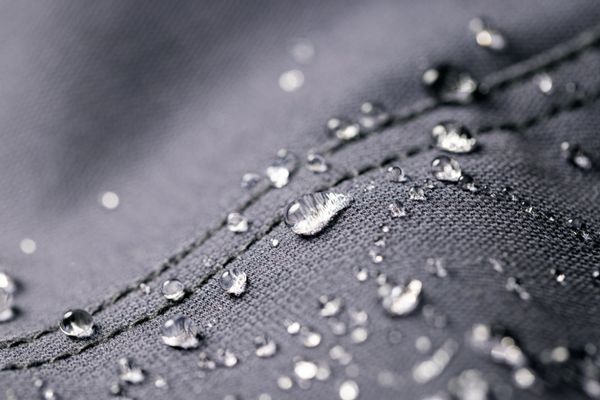
Second, it’s light-weight, so it won’t add too much weight to your backpack. The thinnest nylon fabrics used for backpacks weigh only around 30g/m2, which is about the same weight as the lightest parachutes!
Third, it is water-resistant, so your belongings will stay dry even if it rains for a short while. Much more about this ability in the remainder of this article!
The fourth reason would be that nylon is fairly breathable, which allows humidity to escape your pack and avoid mold or mildew to affect your stuff (e.g. a sleeping pad or a wet tent!).
Many of these qualities are also found in polyester fabrics, but this is often slightly heavier for the same strength but also less expensive.
Are nylon backpacks waterproof or water-resistant?
Nylon backpacks are as a minimum water-resistant. This means that they can tolerate a short rain shower or a quick rinse under the shower, but not longer exposed to heavy rain.
Some nylon backpacks, however, are treated with waterproofing technologies such as silicon (resulting in silnylon), DWR, or other hydrophobic chemicals that make them repel water. Such surface treatments make them last much longer in the rain than untreated backpacks do.
Sometimes these surface treatments can be enough to make nylon virtually waterproof.
For example, tents are often made from very thin (<40D) nylon fabrics that are much thinner than the nylons used for backpacks. However, because of the effective application of silicon or DWR to the tent surface, most tents will easily last a whole night in the pouring rain!
And this is true even when considering that most hiking tents are made from nylon with a thickness between 10D and 40D.
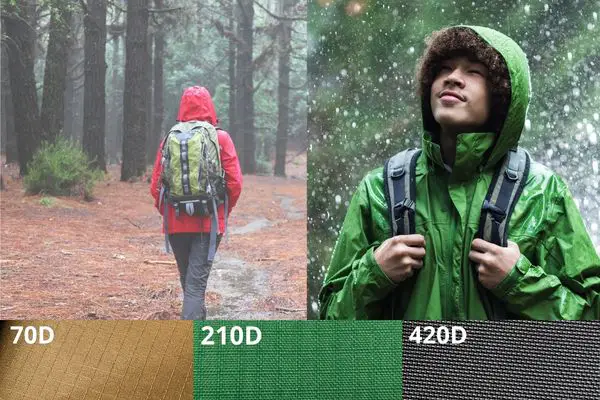
Backpacks on the other hand have a more challenging form factor with dents, bends, cracks, and pockets, which make the fabric somewhat more susceptible to water leakage.
Therefore, few nylon backpacks are fully waterproof. But those made from really thick nylon fabrics with a Denier value of more than 400D that have also been treated with a water repellent chemical are pretty much entirely waterproof in everyday use!
Is Ripstop Nylon Waterproof
Ripstop (rip stop or rip-stop) nylon is the most common nylon material used as it is stronger than ordinary nylon fabric.
Ripstop nylon is a nylon fabric with interwoven reinforcement threads in a crosshatch pattern. It is used in products where durability is important, such as tents, sleeping pads, backpacks, and parachutes. Ordinary nylon fabric does not have reinforcing threads and is not as durable.
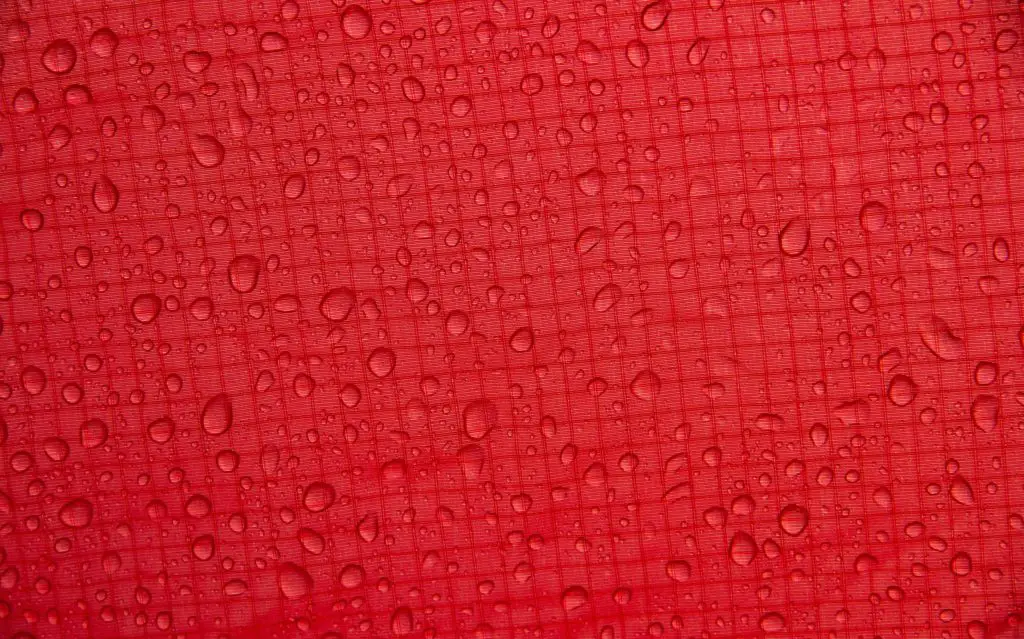
These days, almost all nylon fabrics for outdoor gear are of the ripstop type as they are much stronger in terms of tear and abrasion resistance.
While ripstop nylon is stronger than ordinary nylon, the ripstop technology does nothing to make the nylon fabric more waterproof.
What makes nylon waterproof has to do with the thickness and tightness of weaving, rather than the strength of the fabric as such.
The same is the case for the thicker polyester fabrics that are also used for backpacks.
Can water pass through nylon?
Yes, water can pass through untreated nylon fabric. But it will actually do so to a lesser degree as soon as the first amount of water is absorbed!
Why?
Nylon is, compared to for example polyester, much more willing to absorb moisture and will also expand in the process (that is why your tent sacks in rain!).
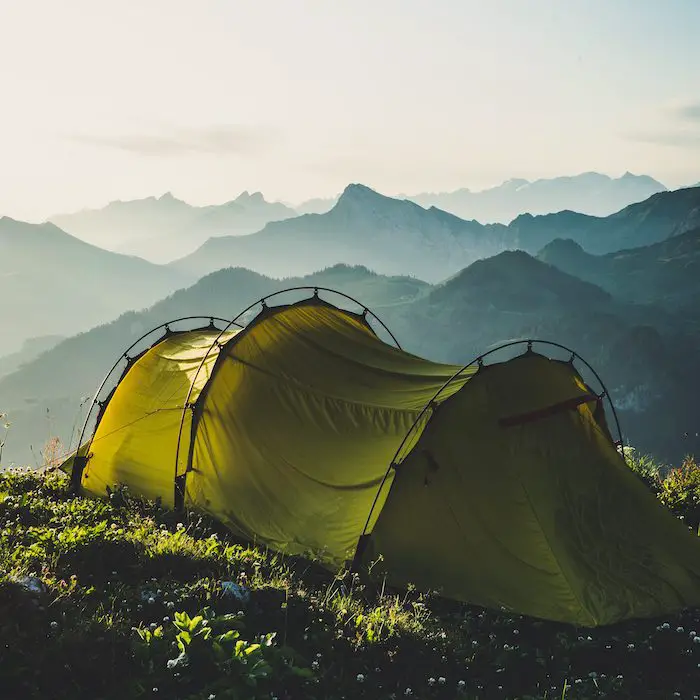
Depending on how thick the nylon in question is, there will be some leakage of water through the fabric when the “hydrostatic pressure” reaches the breakpoint for that fabric.
Below is a table showing the approximate breakpoint values for different nylon fabrics.
| Material | Grams/1000m thread | Avg. Fabric density | Water resistance (Hydrostatic Head) |
| 7D Nylon | 0.8 | 19 g/m² | 1000-2000mm |
| 10D Nylon | 1.1 | 25 g/m² | 1000-2000mm |
| 15D Nylon | 1.7 | 30 g/m² | 2000mm |
| 20D Nylon | 2.2 | 34 g/m² | 3000-4000mm |
| 30D Nylon | 3.3 | 47 g/m² | 4000-5000mm |
| 40D Nylon | 4.4 | 54 g/m² | 5000mmm |
| 210D Nylon | 23.3 | 70 g/m² | 15000mm |
| 400D | 44.4 | 100 g/m² | 20000mm |
Nylon has a tendency to absorb water and a backpack with untreated nylon will therefore slowly absorb water when it rains.
Because the water also makes the nylon threads expand, the fabric actually gets tighter when wet and will therefore increase its water resistance the wetter it gets!
Sounds confusing?
Let me explain: If you have thin nylon threads in a loosely woven fabric, this fabric will be less water-resistant than thicker threads in a tightly woven fabric.
But as nylon gets wet, it absorbs the water into its fibers that expand as a result (an ability not seen to the same degree in polyester fabrics).
Therefore, as the nylon fibers absorb water, the threads get bigger to close off the small gaps between them, which results in a tighter and more water-resistant fabric!
This is a nice feature of nylon, which makes thick nylon fabrics almost entirely waterproof – especially if treated with water repellants as an initial barrier!
How do I know if my backpack is waterproof?
To find out if a backpack is waterproof, check the product description or look for a waterproof rating label.
If you can’t find this information, you can test the backpack yourself by spraying it with water from a hose or filling it with water and seeing if any leaks through.
You may also just pour a few drops of water from a bottle or spoon onto the fabric and see if the fabric repels the water.

If so, the backpack is likely treated with water repellant such as silicon. If not, the water will slowly be absorbed.
However, if a manufacturer puts the effort into making a backpack waterproof, they will usually state so in their description!
A good rule of thumb is that backpacks made from nylon fabrics thicker than 400D, and are treated with a water-repellant, can be considered pretty much waterproof.
Can I make my nylon bag more waterproof?
Sure, there are many ways to make a nylon backpack more waterproof! The best options are:
1. Using a silicon or DWR spray.
2. Using waterproofing detergent.
3. Using an internal waterproof liner or a rain cover.
Using waterproofing sprays
If you want to keep your backpack and its contents dry in wet weather, the easiest option is to use a silicon or DWR spray to make it more waterproof.
Here’s a step-by-step guide:
- Start by thoroughly cleaning your backpack with soap and water. This will help the DWR or silicon spray to adhere better.
- Once your backpack is clean, shake the spray can well and apply it evenly to the surface of the backpack.
- Allow the silicon/DWR spray to dry completely before using or storing your backpack inside!
It is best to perform this treatment outdoors as these sprays are not healthy to inhale, but they can also be performed in a well-ventilated room.
Using DWR waterproofing detergent
Another way to make your backpack more waterproof is by using DWR detergent. This type of detergent can be found at most outdoor or camping stores and it is applied during washing in a laundry machine.
While not made specifically for backpacks, the same DWR products that are used for jackets can also be used for most types of nylon backpacks as many rain jackets are also made from nylon.
DWR is most often made from fluoropolymers. Fluoropolymers are a type of synthetic polymer that contains fluorine atoms.
This gives the polymer material water-repellent and non-stick properties. Fluoropolymers are often used to coat fabric or other materials to make them waterproof.
They perform well in very wet weather but can be damaged by heat and sunlight. They are also quite expensive and will wash off with time.
To use it, simply follow these steps:
- First, make sure to remove loose strings and all the contents of the pack!
- Next, if your pack is very dirty, clean it with soap and water to remove most of the dirt or debris.
- Put your backpack in the washing machine and follow the washing instructions on the detergent bottle. Usually, a medium-temperature program with slow centrifugation at the end is recommended.
- Dry the backpack. Sometimes, depending on the product used, it is recommended to use a tumble drier but this is only necessary when you use these detergents for membrane rain jackets. I would always recommend air drying as the heat of a tumble drier may damage the nylon.
- If you find that your backpack is still not waterproof after following these steps, you may need to reapply the DWR detergent, use more of it, or consider using a different type of waterproofing treatment.
Always remember to be careful with the washing program for a backpack, and always read the instructions on the label of the detergent.
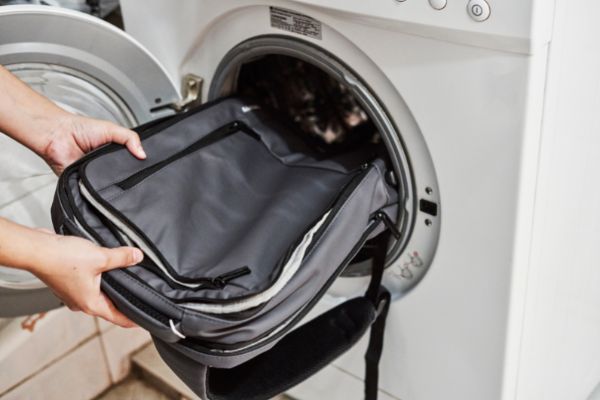
Also, if you have a backpack with a metal frame, either remove the metal parts or use one of my other methods listed here.
Using an internal waterproof liner or an outer rain cover
This method is the most efficient but does require some modification of the pack, which may or may not be doable depending on the model.
Here is a general method:
- Purchase a waterproof backpack liner made from a waterproof material. An ordinary PE plastic bag in the right size may also be used!
- Place the liner inside your backpack, making sure that it covers the entire interior surface area.
- Close up your backpack and cinch all of the straps tight so that the liner is held in place.
- If necessary, use duct tape or another adhesive to further secure the liner to the interior of your backpack.
An external rain cover is also an efficient solution as you do not have to do anything to the backpack and it often makes it fully waterproof.
The downside is that you will have to carry it around and that it may be impractical to put on and access equipment when on.
How to completely waterproof a nylon backpack?
Without using a rain cover, it is hard to make a nylon backpack completely waterproof.
DWR and silicon spray can get you a long way, but it will not make a pack made from thin nylon fabric of less than 400D completely waterproof.
Which bag materials are completely waterproof?
The most waterproof backpack materials are: Polyurethane (PU), Dyneema, Rubber, polyvinyl chloride (PVC), silicone elastomer, and leather.
I will go through each of these materials in more detail below.
Polyurethane
Of the materials listed here, polyurethane is the most widely used for modern waterproof backpacks. It has a rubber-like feel to it and is completely waterproof – to the extent that you can use it for swimming and kayaking!
Here are three examples of some good quality PU backpacks:
Polyurethane is as waterproof but much lighter than the PVC material, which is also often used in the manufacture of backpacks. But PVC is not great for the environment.
It is also much lighter in weight than rubber, and also more comfortable to wear as it allows some breathability. Polyurethane is also resistant to degradation from heat and sunlight.
Dyneema
While not widely used, Dyneema is the technically most advanced fabric!
Dyneema is a high-performance polyethylene fiber that is used in a variety of applications where strength, durability, and lightweight properties are desired. The material is often used in outdoor gear and equipment, such as backpacks, as it is waterproof and resistant to abrasion.
I will not go further into this material as I already wrote an article comparing it to nylon here.
Rubber
If you have ever worn a pair of rubber boots, you will know how waterproof rubber is!
Rubber is perhaps the oldest material used to make waterproof packs. Backpacks made with waterproof rubber are ideal for use in very wet weather, as they will keep the contents of the backpack completely dry.
However, rubber has a tendency to fall apart and degrade when exposed to heat and sunlight. It is also heavy in use and somewhat cold and uncomfortable to wear on your bag as no breathing through the material is allowed.
Silicone elastomer is a type of rubber that is used in many waterproof products, including backpacks. It is very durable and can withstand exposure to sunlight and heat better without degrading.
However, as traditional rubber, it is not lightweight or very comfortable to wear.
PVC
PVC is a synthetic plastic that is also used to make waterproof backpacks. PVC is fairly lightweight, durable, and inexpensive, making it a popular choice for backpack manufacturers. It is also easy to make in many different colors.
However, PVC is not as environmentally friendly as some other materials and can be toxic if it melts or burns. Therefore it is prohibited in many countries.
Leather
Leather is a naturally waterproof material, and it has been used to make backpacks for centuries. Leather packs are very tough and durable, making them ideal for use in rugged conditions.

However, leather is not as breathable as other materials, so it can be uncomfortable to wear in hot weather. It is also more expensive and quite heavy to carry!
What are some good waterproof backpacks?
There are many different brands offering waterproof and functional backpacks out there. I particularly like the Scandinavian brand Fjällräven as they offer a few modern options that can also be used for everyday purposes.
Waterproof backpacks from Fjällräven
If you are a returning reader of my blog, you will know that I have already written a post about waterproof backpacks from Fjällräven.
Fjällräven makes a ton of outdoor gear, including backpacks, that are often made from G-1000 fabric or their so-called “Vinylon F” material.
G-1000 is a material that is used in high-end backpacks. If it is treated with so-called “Greenland wax”, it can be made highly waterproof and can withstand a lot of abuse.
It is also quite comfortable to wear, as it is breathable and the backpacks made from it usually have a lot of padding.
I personally own and enjoy their Abisko hiking backpack, which is so durable and functional that I believe will last me the rest of my days… It is made from G-1000 so it can be made fully waterproof by applying Greenland Wax.
Vinylon F is a synthetic fiber that is often used to make waterproof packs. This material is strong and tear-resistant, making it ideal for use in harsh conditions. It is also lightweight and comfortable to wear, making it a good choice for long hikes. However, Vinylon F can be expensive and difficult to find.
Fjällräven also offers several fully waterproof backpacks made from their BERGSHELL fabric. BERGSHELL means mountain shell and is a strong and waterproof fabric containing 400D nylon fused with TPU to make it fully waterproof.
Examples of fully waterproof backpacks from Fjällräven are the Bergtagen and Keb rucksack for hiking and the Ulvö for every day (school and work) activities.
The Ulvö rolltop variant of the Ulvö backpack has a closing mechanism similar to waterproof stuff sacks that makes it even harder for water to enter. If you are looking for a completely waterproof alternative to the Kankan rucksack, the Ulvö pack may be a perfect choice.

